Ecosystem Services Research in Green Sustainable Science and Technology Field: Trends, Issues, and Future Directions
Abstract
1. Introduction
2. Materials and Methods
2.1. Data Acquisition
2.2. Bibliometric Analysis
3. Discussion and Results
3.1. Discipline Co-Occurrence Analysis
3.2. Publication Characteristics Analysis
3.3. Partnership Analysis
3.4. Keyword Co-Occurrence Analysis
3.5. Co-Citation Analysis
3.5.1. Landscape View
3.5.2. Timeline View
3.5.3. References with Strongest Citation Bursts
3.5.4. Cluster Analysis
Cluster #0—Mapping Ecosystem Service
Cluster #1—Spatial Gradient Difference
Cluster #2—Ecosystem Service Value
Cluster #3—Water-Related Ecosystem Service
Cluster #4—Linking Forest Landscape Model
Cluster #5—Culture Ecosystem Service
Cluster #9—Ecosystem Service Relationship
Cluster #11—Different Socio-Ecological Context
3.6. Structural Variation Analysis (SVA)
4. Conclusions and Policy Implications
Author Contributions
Funding
Institutional Review Board Statement
Informed Consent Statement
Data Availability Statement
Acknowledgments
Conflicts of Interest
References
- Kates, R.W. What kind of a science is sustainability science? Proc. Natl. Acad. Sci. USA 2011, 108, 19449. [Google Scholar]
- Wang, B.; Zhang, Q.; Cui, F. Scientific research on ecosystem services and human well-being: A bibliometric analysis. Ecol. Indic. 2021, 125, 107449. [Google Scholar] [CrossRef]
- Torres, A.V.; Tiwari, C.; Atkinson, S.F. Progress in ecosystem services research: A guide for scholars and practitioners. Ecosyst. Serv. 2021, 49, 101267. [Google Scholar] [CrossRef]
- Chen, C. CiteSpace II: Detecting and visualizing emerging trends and transient patterns in scientific literature. J. Am. Soc. Inf. Sci. Technol. 2006, 57, 359–377. [Google Scholar] [CrossRef]
- Aleixandre-Benavent, R.; Aleixandre-Tudó, J.L.; Castelló-Cogollos, L.; Aleixandre, J.L. Trends in scientific research on climate change in agriculture and forestry subject areas (2005–2014). J. Clean. Prod. 2017, 147, 406. [Google Scholar] [CrossRef]
- Liu, C.; Gui, Q. Mapping intellectual structures and dynamics of transport geography research: A scientometric overview from 1982 to 2014. Scientometrics 2016, 109, 159–184. [Google Scholar] [CrossRef]
- Chen, C. Science Mapping: A Systematic Review of the Literature. J. Data Inf. Sci. 2017, 2, 1–40. [Google Scholar] [CrossRef]
- Shi, Y.; Liu, X. Research on the Literature of Green Building Based on the Web of Science: A Scientometric Analysis in CiteSpace (2002–2018). Sustainability 2019, 11, 3716. [Google Scholar] [CrossRef]
- Aznar-Sánchez, J.A.; Belmonte-Ureña, M.J.; López-Serrano, J.F.; Velasco-Muñoz, J.F. Forest ecosystem services: An analysis of worldwide research Forests. Forests 2018, 9, 453. [Google Scholar]
- Liu, W.; Wang, J.; Li, C.; Chen, B.; Sun, Y. Using Bibliometric Analysis to Understand the Recent Progress in Agroecosystem Services Research. Ecol. Econ. 2019, 156, 293–305. [Google Scholar] [CrossRef]
- Chen, C. A Glimpse of the First Eight Months of the COVID-19 Literature on Microsoft Academic Graph: Themes, Citation Contexts, and Uncertainties. Front. Res. Metrics Anal. 2020, 5, 607286. [Google Scholar] [CrossRef]
- Hood, W.W.; Wilson, C.S. The literature of bibliometrics, scientometrics, and informetrics. Scientometrics 2001, 52, 291. [Google Scholar] [CrossRef]
- Yang, H.; Shao, X.; Wu, M. A review on ecosystem health research: A visualization based on CiteSpace. Sustainability 2019, 11, 4908. [Google Scholar] [CrossRef]
- Zhao, D.; Strotmann, A. Analysis and visualization of citation networks. In Synthesis Lectures on Information Concepts Retrieval & Services; Morgan & Claypool Publishers: San Rafael, CA, USA, 2015. [Google Scholar]
- Börner, K.; Chen, C.; Boyack, K.W. Visualizing knowledge domains. Annu. Rev. Inf. Sci. Technol. 2003, 37, 179. [Google Scholar] [CrossRef]
- Yi, Y.; Luo, J.; Wübbenhorst, M. Research on political instability, uncertainty and risk during 1953–2019: A scientometric review. Scientometrics 2020, 123, 1051–1076. [Google Scholar] [CrossRef]
- Bennett, E.M.; Cramer, W.; Begossi, A.; Cundill, G.; Díaz, S.; Egoh, B.N.; Geijzendorffer, I.R.; Krug, C.B.; Lavorel, S.; Lazos, E.; et al. Linking biodiversity, ecosystem services, and human well-being: Three challenges for de-signing research for sustainability. Curr. Opin. Environ. Sustain. 2015, 14, 76–85. [Google Scholar] [CrossRef]
- Elmqvist, T.; Setälä, H.; Handel, S.N.; Van Der Ploeg, S.; Aronson, J.; Blignaut, J.N.; Gomez-Baggethun, E.; Nowak, D.J.; Kronenberg, J.; De Groot, R. Benefits of restoring ecosystem services in urban areas. Curr. Opin. Environ. Sustain. 2015, 14, 101–108. [Google Scholar] [CrossRef]
- Salzman, J.; Bennett, G.; Carroll, N.; Goldstein, A.; Jenkins, M. The global status and trends of Payments for Ecosystem Services. Nat. Sustain. 2018, 1, 136–144. [Google Scholar] [CrossRef]
- Plieninger, T.; Bieling, C.; Fagerholm, N.; Byg, A.; Hartel, T.; Hurley, P.; López-Santiago, C.A.; Nagabhatla, N.; Oteros-Rozas, E.; Raymond, C.M.; et al. The role of cultural ecosystem services in landscape management and planning. Curr. Opin. Environ. Sustain. 2015, 14, 28–33. [Google Scholar] [CrossRef]
- Berbés-Blázquez, M.; González, J.A.; Pascual, U. Towards an ecosystem services approach that addresses social power rela-tions. Curr. Opin. Environ. Sustain. 2016, 19, 134–143. [Google Scholar] [CrossRef]
- Lescourret, F.; Magda, D.; Richard, G.; Adam-Blondon, A.-F.; Bardy, M.; Baudry, J.; Doussan, I.; Dumont, B.; Lefèvre, F.; Litrico, I.; et al. A social–ecological approach to managing multiple agro-ecosystem services. Curr. Opin. Environ. Sustain. 2015, 14, 68–75. [Google Scholar] [CrossRef]
- Gao, J.; Li, F.; Gao, H.; Zhou, C.; Zhang, X. The impact of land-use change on water-related ecosystem services: A study of the Guishui River Basin, Beijing, China. J. Clean. Prod. 2017, 163, S148–S155. [Google Scholar] [CrossRef]
- Li, F.; Liu, X.; Zhang, X.; Zhao, D.; Liu, H.; Zhou, C.; Wang, R. Urban ecological infrastructure: An integrated network for ecosystem services and sustainable urban systems. J. Clean. Prod. 2017, 163, S12–S18. [Google Scholar] [CrossRef]
- Garbach, K.; Milder, J.C.; DeClerck, F.A.J.; Montenegro de Wit, M.; Driscoll, L.; Gemmill-Herren, B. Examining mul-ti-functionality for crop yield and ecosystem services in five systems of agroecological intensification. Int. J. Agric. Sustain. 2017, 15, 11–28. [Google Scholar] [CrossRef]
- Calvet-Mir, L.; Corbera, E.; Martin, A.; Fisher, J.; Gross-Camp, N. Payments for ecosystem services in the tropics: A closer look at effectiveness and equity. Curr. Opin. Environ. Sustain. 2015, 14, 150–162. [Google Scholar] [CrossRef]
- Ma, X.; Zhang, L.; Wang, J.; Luo, Y. Knowledge domain and emerging trends on echinococcosis research: A scientometric analysis. Int. J. Environ. Res. Public Health 2019, 16, 842. [Google Scholar] [CrossRef]
- Xiao, F.; Li, C.; Sun, J.; Zhang, L. Knowledge domain and emerging trends in organic photovoltaic technology: A scientometric review based on citespace analysis. Front. Chem. 2017, 5, 67. [Google Scholar]
- Chu, S.M.; Tang, H.; Huang, T.S. Locality preserving speaker clustering. In Proceedings of the 2009 IEEE International Conference on Multimedia and Expo, IEEE, New York, NY, USA, 28 June–3 July 2009; Volume 6, pp. 494–497. [Google Scholar]
- Kim, M.C.; Zhu, Y. Scientometrics of scientometrics: Mapping historical footprint and emerging technologies in scientometrics. Scientometrics 2018, 1, 9–27. [Google Scholar]
- De Groot, R.S.; Alkemade, R.; Braat, L.; Hein, L.; Willemen, L. Challenges in integrating the concept of ecosystem services and values in landscape planning, management and decision making. Ecol. Complex. 2010, 7, 260–272. [Google Scholar] [CrossRef]
- Fisher, B.; Turner, R.K.; Morling, P. Defining and classifying ecosystem services for decision making. Ecol. Econ. 2009, 68, 643–653. [Google Scholar] [CrossRef]
- Raudsepp-Hearne, C.; Peterson, G.D.; Bennett, E.M. Ecosystem service bundles for analyzing tradeoffs in diverse landscapes. Proc. Natl. Acad. Sci. USA 2010, 107, 5242. [Google Scholar] [CrossRef] [PubMed]
- Bennett, E.M.; Peterson, G.D.; Gordon, L.J. Understanding relationships among multiple ecosystem services. Ecol. Lett. 2009, 12, 1394–1404. [Google Scholar] [CrossRef] [PubMed]
- Carpenter, S.R.; Mooney, H.A.; John, A.; Doris, C.; Defries, R.S.; Sandra, D.; Thomas, D.; Duraiappah, A.K.; Oteng-Yeboah, A.; Pereira, H.M.; et al. Science for managing ecosystem services: Beyond the Millennium Ecosystem Assessment. Prac. Natl. Acad. Sci. USA 2009, 106, 1305–1312. [Google Scholar] [CrossRef] [PubMed]
- Gómez-Baggethun, E.; De Groot, R.; Lomas, P.L.; Montes, C. The history of ecosystem services in economic theory and practice: From early notions to markets and payment schemes. Ecol. Econ. 2010, 69, 1209. [Google Scholar] [CrossRef]
- Daily, G.C.; Polasky, S.; Goldstein, J.; Kareiva, P.M.; Mooney, H.A.; Pejchar, L.; Ricketts, T.H.; Salzman, J.; Shallenberger, R. Ecosystem services in decision making: Time to deliver. Front. Ecol. Environ. 2009, 7, 21–28. [Google Scholar] [CrossRef]
- Muradian, R.; Corbera, E.; Pascual, U.; Kosoy, N.; May, P.H. Reconciling theory and practice: An alternative conceptual framework for understanding payments for environmental services. Ecol. Econ. 2010, 69, 1202–1208. [Google Scholar] [CrossRef]
- Power, A.G. Ecosystem services and agriculture: Tradeoffs and synergies. Philos. T. R. Soc. B. 2010, 365, 2959–2971. [Google Scholar] [CrossRef]
- Nelson, E.; Mendoza, G.; Regetz, J.; Polasky, S.; Tallis, H.; Cameron, D.R.; Chan, K.M.A.; Daily, G.C.; Goldstein, J.; Kareiva, P.M.; et al. Modeling multiple ecosystem services, biodiversity conservation, commodity production, and tradeoffs at landscape scales. Front. Ecol. Environ. 2009, 7, 4–11. [Google Scholar] [CrossRef]
- Kumar, P. The Economics of Ecosystems and Biodiversity: Ecological and Economic Foundations; Routledge: London, UK, 2010. [Google Scholar]
- Hauck, J.; Görg, C.; Varjopuro, R.; Ratamäki, O.; Jax, K. Benefits and limitations of the ecosystem services concept in environmental policy and decision making: Some stakeholder perspectives. Environ. Sci. Policy 2013, 25, 13–21. [Google Scholar] [CrossRef]
- Burkhard, B.; Kroll, F.; Müller, F.; Windhorst, W. Landscapes’ capacities to provide ecosystem services—A concept for land-cover based assessments. Landsc. Online 2009, 15, 1. [Google Scholar] [CrossRef]
- Norgaard, R.B. Ecosystem services: From eye-opening metaphor to complexity blinder. Ecol. Econ. 2010, 69, 1219–1227. [Google Scholar] [CrossRef]
- Villamagna, A.M.; Angermeier, P.L.; Bennett, E.M. Capacity, pressure, demand, and flow: A conceptual framework for analyzing ecosystem service provision and delivery. Ecol. Complex. 2013, 15, 114–121. [Google Scholar] [CrossRef]
- Wang, Z.; Mao, D.; Li, L.; Jia, M.; Dong, Z.; Miao, Z.; Ren, C.; Song, C. Quantifying changes in multiple ecosystem services during 1992–2012 in the Sanjiang Plain of China. Sci. Total. Environ. 2015, 514, 119–130. [Google Scholar] [CrossRef] [PubMed]
- Maes, J.; Egoh, B.; Willemen, L.; Liquete, C.; Vihervaara, P.; Schägner, J.P.; Grizzetti, B.; Drakou, E.G.; La Notte, A.; Zulian, G.; et al. Mapping ecosystem services for policy support and decision making in the European Union. Ecosyst. Serv. 2012, 1, 31–39. [Google Scholar] [CrossRef]
- Polasky, S.; Nelson, E.; Pennington, D.; Johnson, K.A. The Impact of Land-Use Change on Ecosystem Services, Biodiversity and Returns to Landowners: A Case Study in the State of Minnesota. Environ. Resour. Econ. 2010, 48, 219–242. [Google Scholar] [CrossRef]
- Turner, K.G.; Odgaard, M.V.; Bøcher, P.K.; Dalgaard, T.; Svenning, J.-C. Bundling ecosystem services in Denmark: Trade-offs and synergies in a cultural landscape. Landsc. Urban Plan. 2014, 125, 89–104. [Google Scholar] [CrossRef]
- De Groot, R.; Brander, L.; Van der Ploeg, S.; Costanza, R.; Bernard, F.; Braat, L.; Christie, M.; Crossman, N.; Ghermandi, A.; Hein, L.; et al. Global estimates of the value of ecosystems and their services in monetary unit. Ecosyst. Serv. 2012, 1, 50. [Google Scholar] [CrossRef]
- Haase, D.; Frantzeskaki, N.; Elmqvist, T. Ecosystem services in urban landscapes: Practical applications and governance implications. Ambio 2014, 43, 407–412. [Google Scholar] [CrossRef]
- Zhou, D.; Tian, Y.; Jiang, G. Spatio-temporal investigation of the interactive relationship between urbanization and ecosystem services: Case study of the Jingjinji urban agglomeration, China. Ecol. Indic. 2018, 95, 152–164. [Google Scholar] [CrossRef]
- Vollmer, D.; Pribadi, D.O.; Remondi, F.; Rustiadi, E.; Gret-Regamey, A. Prioritizing ecosystem services in rapidly urbanizing river basins: A spatial multi-criteria analytic approach. Sustain. Cities Soc. 2016, 20, 237. [Google Scholar] [CrossRef]
- Depellegrin, D.; Pereira, P.; Misiune, L.; Egarter-Vigl, L. Mapping ecosystem services potential in Lithuania. Int. J. Sustain. Dev. World Ecol. 2016, 23, 441. [Google Scholar] [CrossRef]
- Vrbičanová, G.; Kaisová, D.; Močko, M.; Petrovič, F.; Mederly, P. Mapping Cultural Ecosystem Services Enables Better Informed Nature Protection and Landscape Management. Sustainability 2020, 12, 2138. [Google Scholar] [CrossRef]
- Braat, L.C.; De Groot, R. The ecosystem services agenda: Bridging the worlds of natural science and economics, conservation and development, and public and private policy. Ecosyst. Serv. 2012, 1, 4. [Google Scholar] [CrossRef]
- Burkhard, B.; Kroll, F.; Nedkov, S.; Müller, F. Mapping ecosystem service supply, demand and budgets. Ecol. Indic. 2012, 21, 17–29. [Google Scholar] [CrossRef]
- La Notte, A.; D’Amato, D.; Mäkinen, H.; Paracchini, M.L.; Liquete, C.; Egoh, B.; Geneletti, D.; Crossman, N. Ecosystem services classification: A systems ecology perspective of the cascade framework. Ecol. Indic. 2017, 74, 392–402. [Google Scholar] [CrossRef] [PubMed]
- Shen, J.; Li, S.; Liu, L.; Liang, Z.; Wang, Y.; Wang, H.; Wu, S. Uncovering the relationships between ecosystem services and social-ecological drivers at different spatial scales in the Beijing-Tianjin-Hebei region. J. Clean. Prod. 2021, 290, 125193. [Google Scholar] [CrossRef]
- Li, X.; Zhang, H.; Zhang, Z.; Feng, J.; Liu, K.; Hua, Y.; Pang, Q. Spatiotemporal Changes in Ecosystem Services along a Urban-Rural-Natural Gradient: A Case Study of Xi’an, China. Sustainability 2020, 12, 1133. [Google Scholar] [CrossRef]
- Xu, Q.; Yang, R.; Zhuang, D.; Lu, Z. Spatial gradient differences of ecosystem services supply and demand in the Pearl River Delta region. J. Clean. Prod. 2021, 279, 123849. [Google Scholar] [CrossRef]
- Wu, J. Landscape sustainability science: Ecosystem services and human well-being in changing landscapes. Landsc. Ecol. 2013, 28, 999–1023. [Google Scholar] [CrossRef]
- Spake, R.; Lasseur, R.; Crouzat, E.; Bullock, J.M.; Lavorel, S.; Parks, K.E.; Schaafsma, M.; Bennett, E.M.; Maes, J.; Mulligan, M.; et al. Unpacking ecosystem service bundles: Towards predictive mapping of synergies and trade-offs between ecosystem services. Glob. Environ. Chang. 2017, 47, 37–50. [Google Scholar] [CrossRef]
- Xi, H.; Cui, W.; Cai, L.; Chen, M.; Xu, C. Evaluation and Prediction of Ecosystem Service Value in the Zhoushan Islands Based on LUCC. Sustainability 2021, 13, 2302. [Google Scholar] [CrossRef]
- Ma, S.; Wen, Z. Optimization of land use structure to balance economic benefits and ecosystem services under uncertainties: A case study in Wuhan, China. J. Clean. Prod. 2021, 311, 127537. [Google Scholar] [CrossRef]
- Castillo-Eguskitza, N.; Schmitz, M.F.; Onaindia, M.; Rescia, A.J. Linking biophysical and economic assessments of ecosystem services for a social-ecological approach to conservation planning: Application in a biosphere reserve (Biscay, Spain). Sustainability 2019, 11, 3092. [Google Scholar] [CrossRef]
- Jiang, W.; Fu, B.; Lü, Y. Assessing Impacts of Land Use/Land Cover Conversion on Changes in Ecosystem Services Value on the Loess Plateau, China. Sustainability 2020, 12, 7128. [Google Scholar] [CrossRef]
- Gomez-Baggethun, E.; Barton, D.N. Classifying and valuing ecosystem services for urban planning. Ecol. Econ. 2013, 86, 235. [Google Scholar] [CrossRef]
- Costanza, R.; De Groot, R.; Sutton, P.; Van der Ploeg, S.; Anderson, S.J.; Kubiszewski, I.; Farber, S.; Turner, R.K. Changes in the global value of ecosystem services. Glob. Environ. Chang. 2014, 26, 152. [Google Scholar] [CrossRef]
- Kindu, M.; Schneider, T.; Teketay, D.; Knoke, T. Changes of ecosystem service values in response to land use/land cover dynamics in Munessa–Shashemene landscape of the Ethiopian highlands. Sci. Total. Environ. 2016, 547, 137–147. [Google Scholar] [CrossRef] [PubMed]
- Liu, M.; Min, L.; Zhao, J.; Shen, Y.; Pei, H.; Zhang, H.; Li, Y. The Impact of Land Use Change on Water-Related Ecosystem Services in the Bashang Area of Hebei Province, China. Sustainability 2021, 13, 716. [Google Scholar]
- Liang, J.; Li, S.; Li, X.; Li, X.; Liu, Q.; Meng, Q.; Lin, A.; Li, J. Trade-off analyses and optimization of water-related ecosystem services (WRESs) based on land use change in a typical agricultural watershed, southern China. J. Clean. Prod. 2021, 279, 123851. [Google Scholar] [CrossRef]
- Yang, S.; Bai, Y.; Alatalo, J.M.; Wang, H.; Jiang, B.; Liu, G.; Chen, J. Spatio-temporal changes in water-related ecosystem services provision and trade-offs with food production. J. Clean. Prod. 2021, 286, 125316. [Google Scholar] [CrossRef]
- Cai, W.; Wu, T.; Jiang, W.; Peng, W.; Cai, Y. Integrating Ecosystem Services Supply–Demand and Spatial Relationships for Intercity Cooperation: A Case Study of the Yangtze River Delta. Sustainability 2020, 12, 413. [Google Scholar] [CrossRef]
- Farley, J.; Costanza, R. Payments for ecosystem services: From local to global. Ecol. Econ. 2010, 69, 2060–2068. [Google Scholar]
- Bateman, I.J.; Harwood, A.R.; Mace, G.M.; Watson, R.T.; Abson, D.J.; Andrews, B.; Binner, A.; Crowe, A.; Day, B.H.; Dugdale, S.; et al. Bringing Ecosystem Services into Economic Decision-Making: Land Use in the United Kingdom. Science 2013, 341, 45–50. [Google Scholar] [CrossRef] [PubMed]
- Lawler, J.J.; Lewis, D.J.; Nelson, E.; Plantinga, A.J.; Polasky, S.; Withey, J.C.; Helmers, D.P.; Martinuzzi, S.; Pennington, D.; Radeloff, V.C. Projected land-use change impacts on ecosystem services in the United States. Proc. Natl. Acad. Sci. USA 2014, 111, 7492. [Google Scholar] [CrossRef]
- Ouyang, Z.; Hua, Z.; Yang, X.; Polasky, S.; Liu, J.; Xu, W.; Wang, Q.; Zhang, L.; Xiao, Y.; Rao, E.; et al. Improvements in ecosystem services from investments in natural capital. Science 2016, 352, 1455. [Google Scholar] [CrossRef]
- Haga, C.; Inoue, T.; Hotta, W.; Shibata, R.; Hashimoto, S.; Kurokawa, H.; Machimura, T.; Matsui, T.; Morimoto, J.; Shibata, H. Simulation of natural capital and ecosystem services in a watershed in Northern Japan focusing on the future underuse of nature: By linking forest landscape model and social scenarios. Sustain. Sci. 2019, 14, 89. [Google Scholar] [CrossRef]
- Lhoest, S.; Vermeulen, C.; Fayolle, A.; Jamar, P.; Hette, S.; Nkodo, A.; Maréchal, K.; Dufrêne, M.; Meyfroidt, P. Quantifying the Use of Forest Ecosystem Services by Local Populations in Southeastern Cameroon. Sustainability 2020, 12, 2505. [Google Scholar] [CrossRef]
- Lorilla, R.; Poirazidis, K.; Kalogirou, S.; Detsis, V.; Martinis, A. Assessment of the Spatial Dynamics and Interactions among Multiple Ecosystem Services to Promote Effective Policy Making across Mediterranean Island Landscapes. Sustainability 2018, 10, 3285. [Google Scholar] [CrossRef]
- Martín-López, B.; Iniesta-Arandia, I.; García-Llorente, M.; Palomo, I.; Casado-Arzuaga, I.; Garcia Del Amo, D.; Gomez-Baggethun, E.; Oteros-Rozas, E.; Palacios-Agundez, I.; Willaarts, B.; et al. Uncovering ecosystem service bundles through social preferences. PLoS ONE 2012, 7, 38970. [Google Scholar] [CrossRef]
- Díaz, S.; Demissew, S.; Carabias, J.; Joly, C.; Lonsdale, M.; Ash, N.; Larigauderie, A.; Adhikari, J.R.; Arico, S.; Báldi, A.; et al. The IPBES Conceptual Framework—Connecting Nature and People. Curr. Opin. Environ. Sustain. 2015, 14, 1–16. [Google Scholar] [CrossRef]
- Johnson, M.L.; Campbell, L.K.; Svendsen, E.S.; McMillen, H.L. Mapping Urban Park Cultural Ecosystem Services: A Comparison of Twitter and Semi-Structured Interview Methods. Sustainability 2019, 11, 6137. [Google Scholar] [CrossRef]
- Müller, S.M.; Peisker, J.; Bieling, C.; Linnemann, K.; Reidl, K.; Schmieder, K. The Importance of Cultural Ecosystem Services and Biodiversity for Landscape Visitors in the Biosphere Reserve Swabian Alb (Germany). Sustainability 2019, 11, 2650. [Google Scholar] [CrossRef]
- Giedych, R.; Maksymiuk, G. Specific Features of Parks and Their Impact on Regulation and Cultural Ecosystem Services Provision in Warsaw, Poland. Sustainability 2017, 9, 792. [Google Scholar] [CrossRef]
- Canedoli, C.; Bullock, C.; Collier, M.J. Public participatory mapping of cultural ecosystem services: Citizen perception and park management in the Parco Nord of Milan (Italy). Sustainability 2017, 9, 891. [Google Scholar] [CrossRef]
- Daniel, T.C.; Muhar, A.; Arnberger, A.; Aznar, O.; Boyd, J.W.; Chan, K.M.A.; Costanza, R.; Elmqvist, T.; Flint, C.G.; Gobster, P.H.; et al. Contributions of cultural services to the ecosystem services agenda. Proc. Natl. Acad. Sci. USA 2012, 109, 8812. [Google Scholar] [CrossRef] [PubMed]
- Chan, K.M.; Satterfield, T.; Goldstein, J. Rethinking ecosystem services to better address and navigate cultural values. Ecol. Econ. 2012, 74, 8–18. [Google Scholar] [CrossRef]
- Xu, J.; Wang, S.; Xiao, Y.; Xie, G.; Wang, Y.; Zhang, C.; Li, P.; Lei, G. Mapping the spatiotemporal heterogeneity of ecosystem service relationships and bundles in Ningxia, China. J. Clean. Prod. 2021, 294, 126216. [Google Scholar] [CrossRef]
- Yang, Y.; Zheng, H.; Kong, L.; Huang, B.; Xu, W.; Ouyang, Z. Mapping ecosystem services bundles to detect high- and low-value ecosystem services areas for land use management. J. Clean. Prod. 2019, 225, 11–17. [Google Scholar] [CrossRef]
- Gou, M.; Li, L.; Ouyang, S.; Wang, N.; La, L.; Liu, C.; Xiao, W. Identifying and analyzing ecosystem service bundles and their socioecological drivers in the Three Gorges Reservoir Area. J. Clean. Prod. 2021, 307, 127208. [Google Scholar] [CrossRef]
- Crouzat, E.; Mouchet, M.; Turkelboom, F.; Byczek, C.; Meersmans, J.; Berger, F.; Verkerk, P.J.; Lavorel, S. Assessing bundles of ecosystem services from regional to landscape scale: Insights from the French Alps. J. Appl. Ecol. 2015, 52, 1145. [Google Scholar] [CrossRef]
- Feng, Q.; Zhao, W.; Fu, B.; Ding, J.; Wang, S. Ecosystem service trade-offs and their influencing factors: A case study in the Loess Plateau of China. Sci. Total. Environ. 2017, 607, 1250–1263. [Google Scholar] [CrossRef] [PubMed]
- Schirpke, U.; Ebner, M.; Pritsch, H.; Fontana, V.; Kurmayer, R. Quantifying Ecosystem Services of High Mountain Lakes across Different Socio-Ecological Contexts. Sustainability 2021, 13, 6051. [Google Scholar] [CrossRef]
- Costanza, R.; De Groot, R.; Braat, L.; Kubiszewski, I.; Fioramonti, L.; Sutton, P.; Farber, S.; Grasso, M. Twenty years of ecosystem services: How far have we come and how far do we still need to go? Ecosyst. Serv. 2017, 28, 1–16. [Google Scholar] [CrossRef]
- Chen, C. Predictive effects of structural variation on citation counts. J. Am. Soc. Inf. Sci. Technol. 2012, 63, 431. [Google Scholar] [CrossRef]
- Sharma, S.; Anees, M.M.; Sharma, M.; Joshi, P.K. Longitudinal study of changes in ecosystem services in a city of lakes, Bhopal, India. Energy Ecol. Environ. 2021, 6, 408–424. [Google Scholar] [CrossRef]
- Zhang, J.; Li, X.; Bao, T.; Li, Z.; Liu, C.; Xu, Y. Linking Demographic Factors, Land Use, Ecosystem Services, and Human Well-Being: Insights from an Sandy Landscape, Uxin in Inner Mongolia, China. Sustainability 2021, 13, 4847. [Google Scholar] [CrossRef]
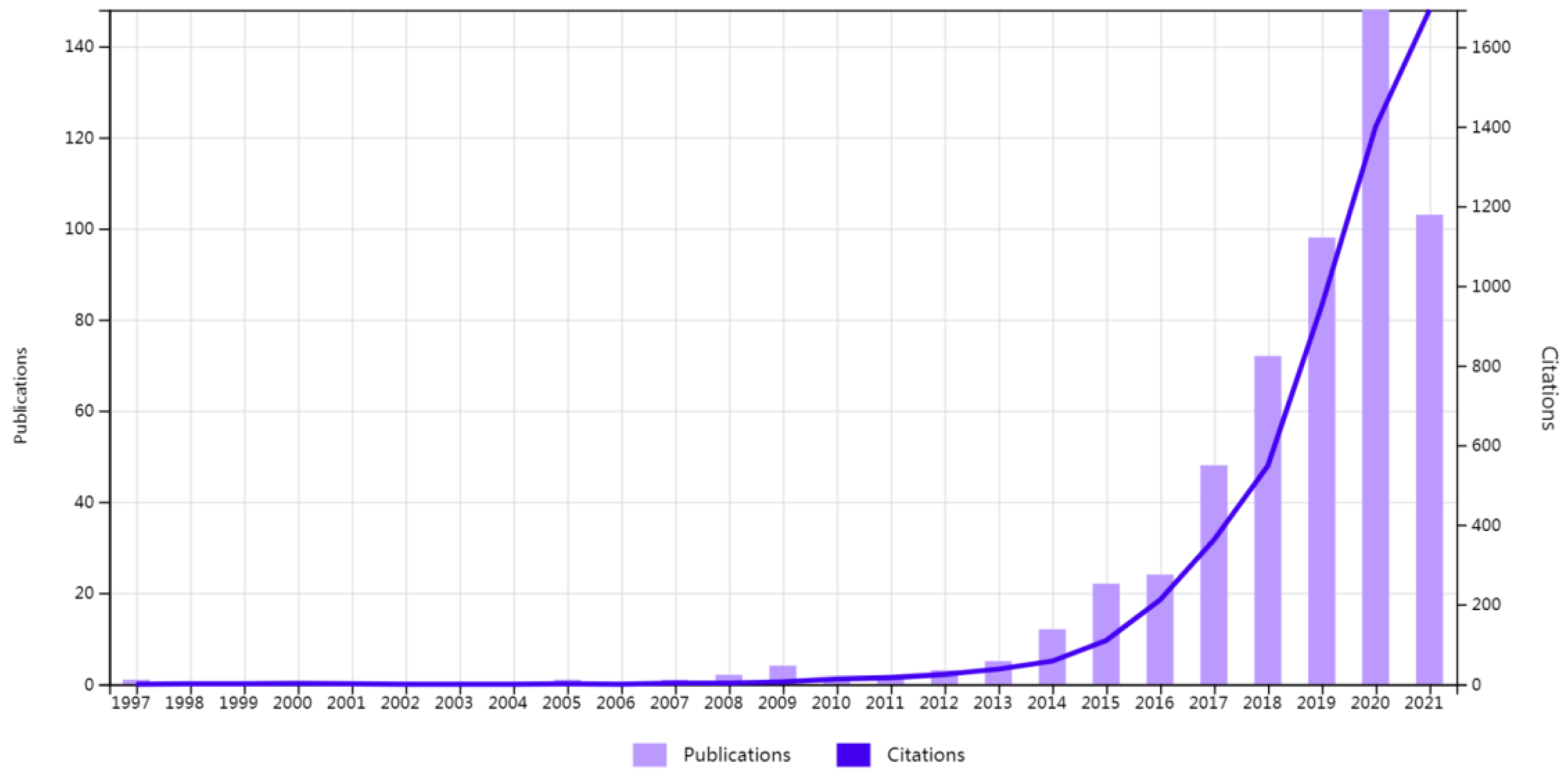
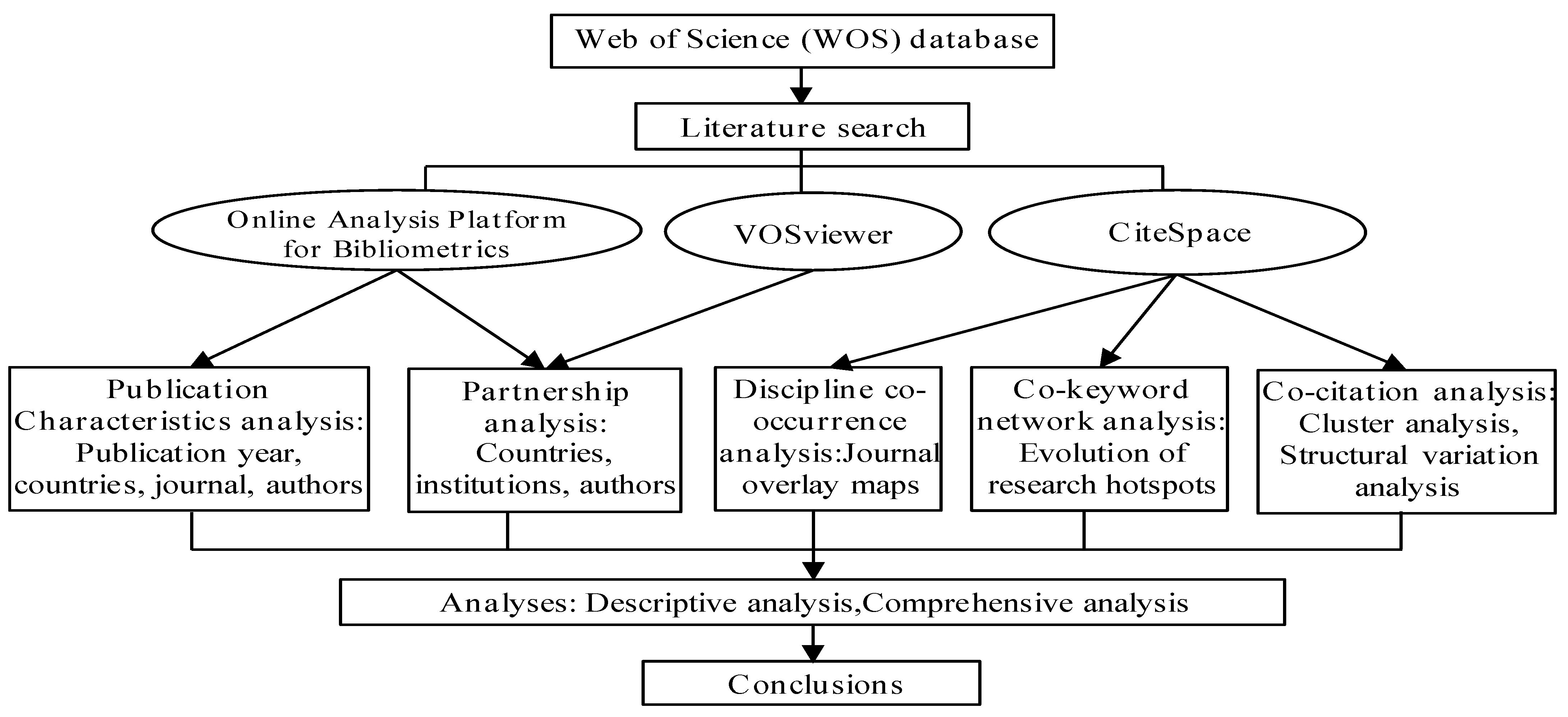

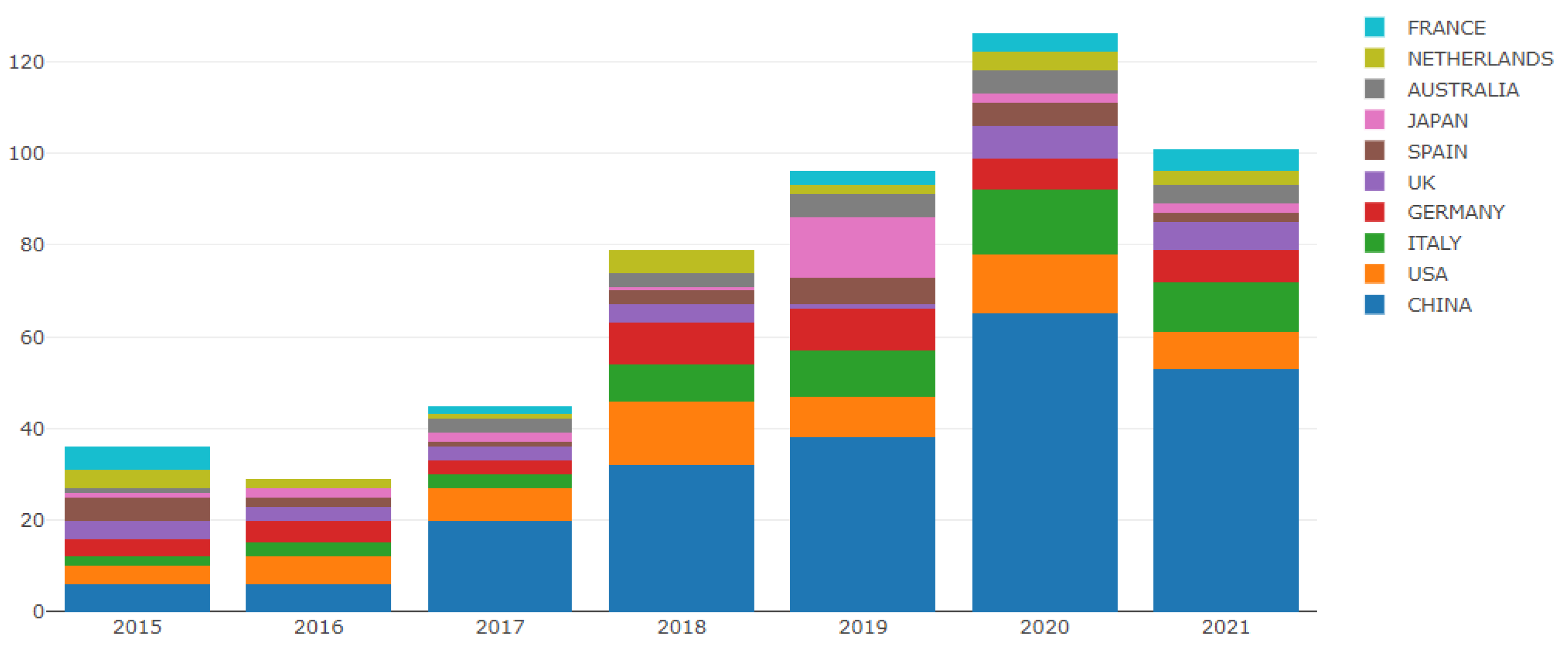
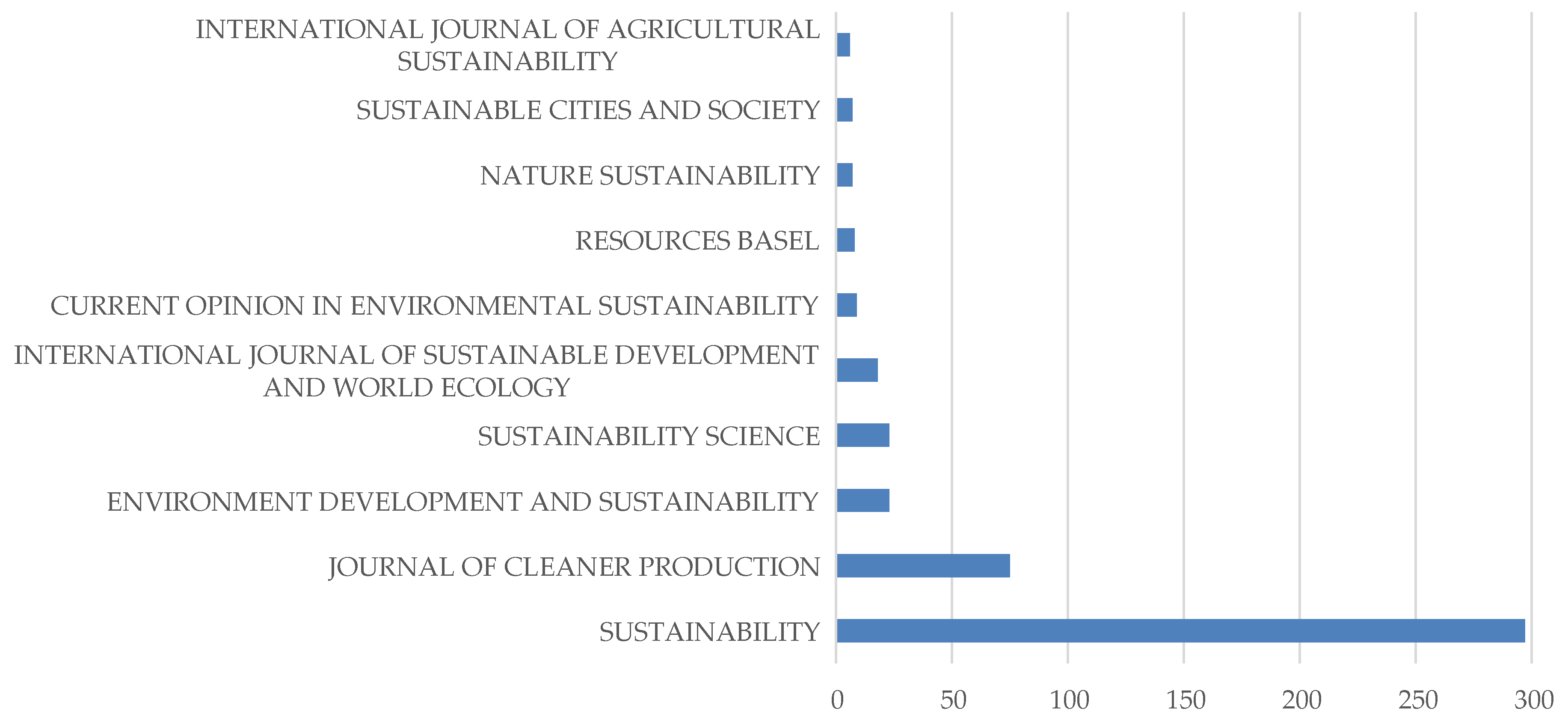
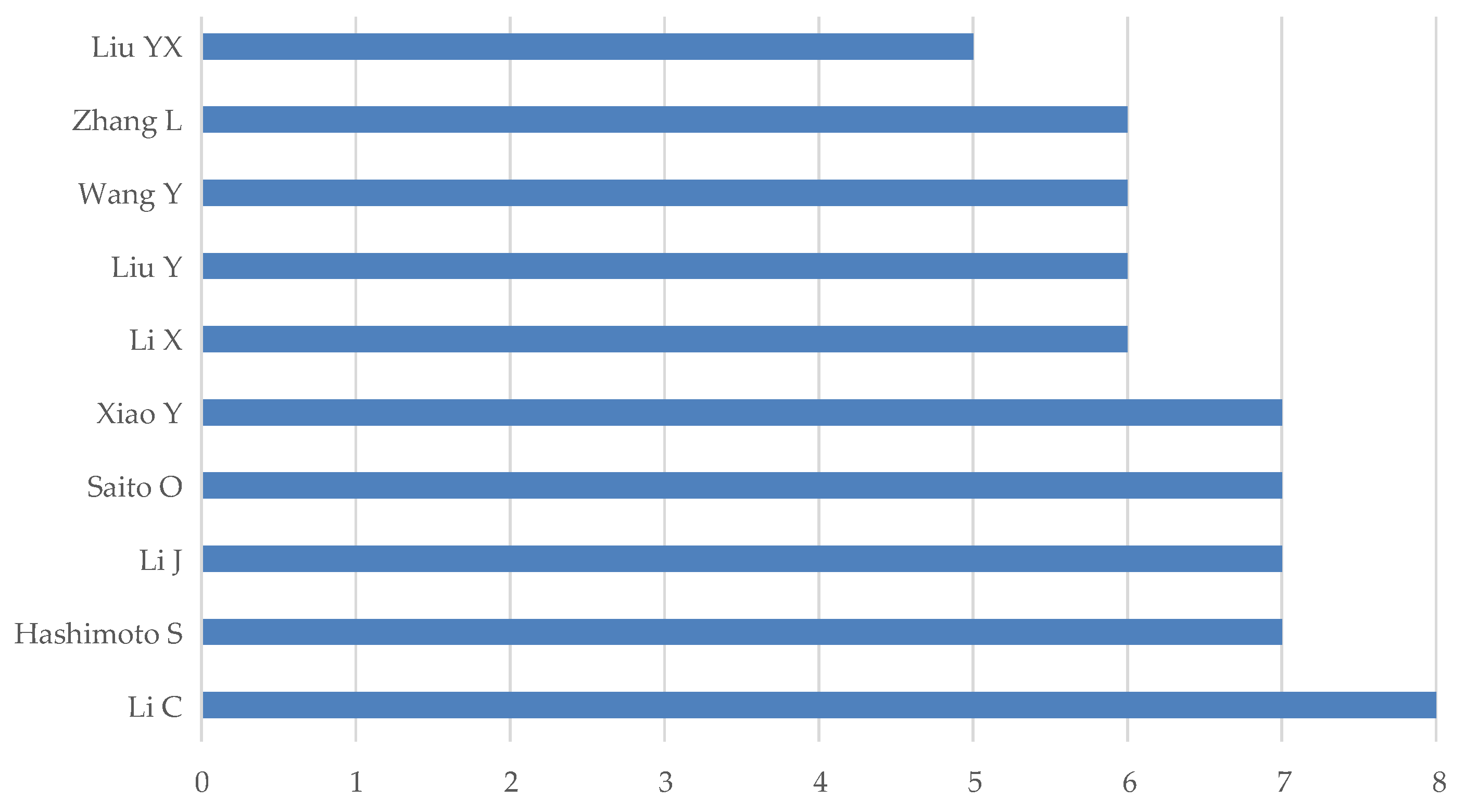


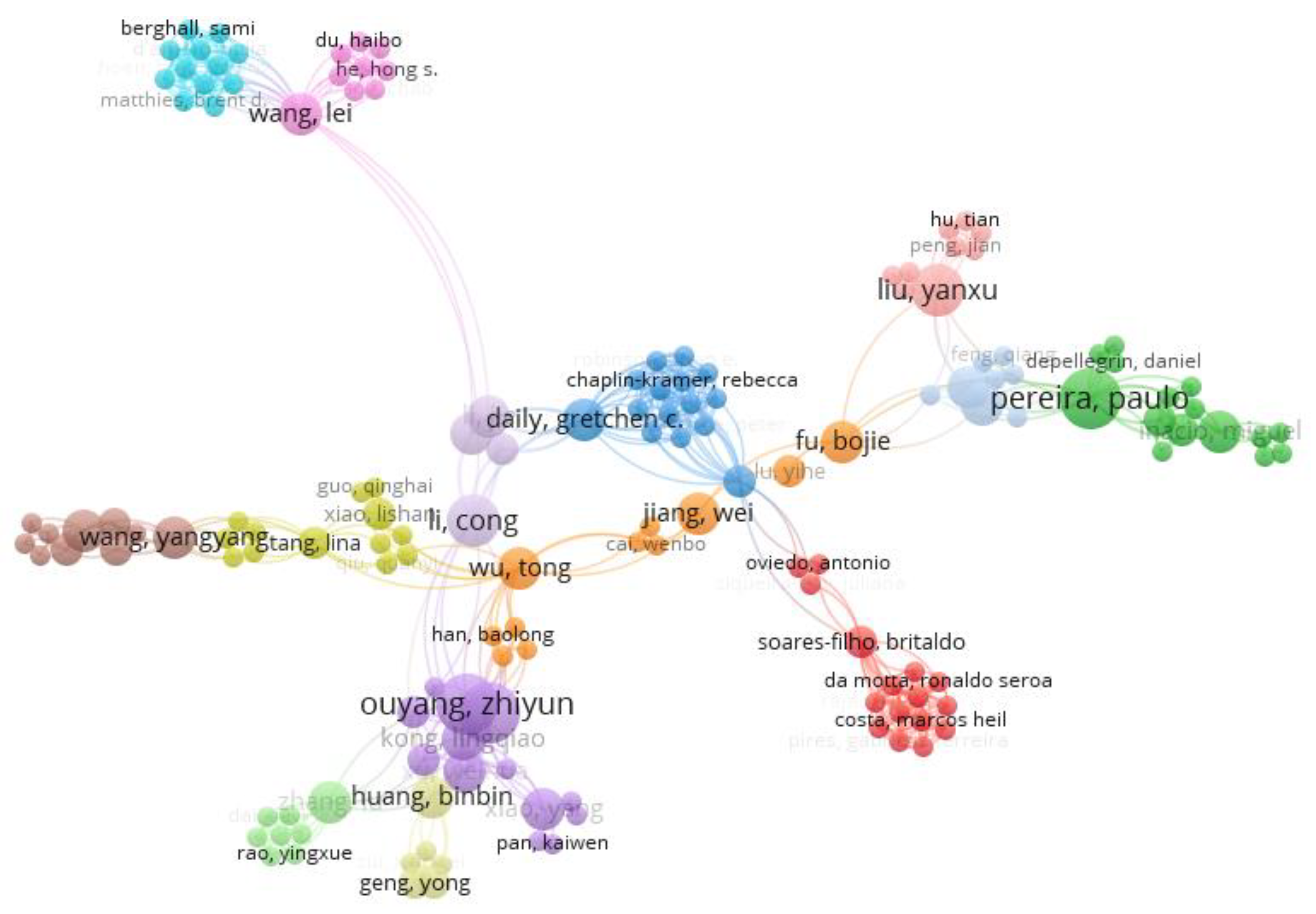
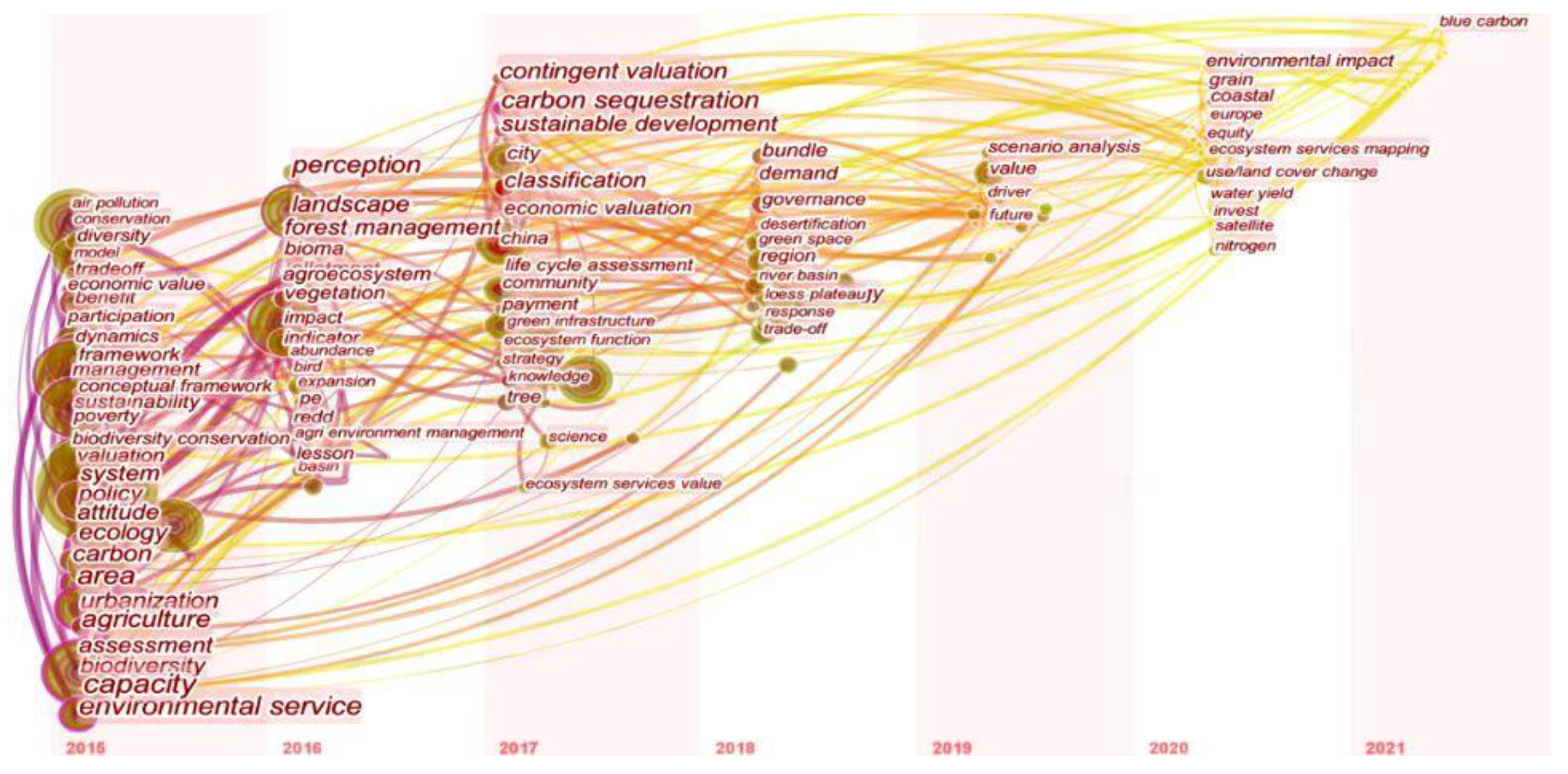

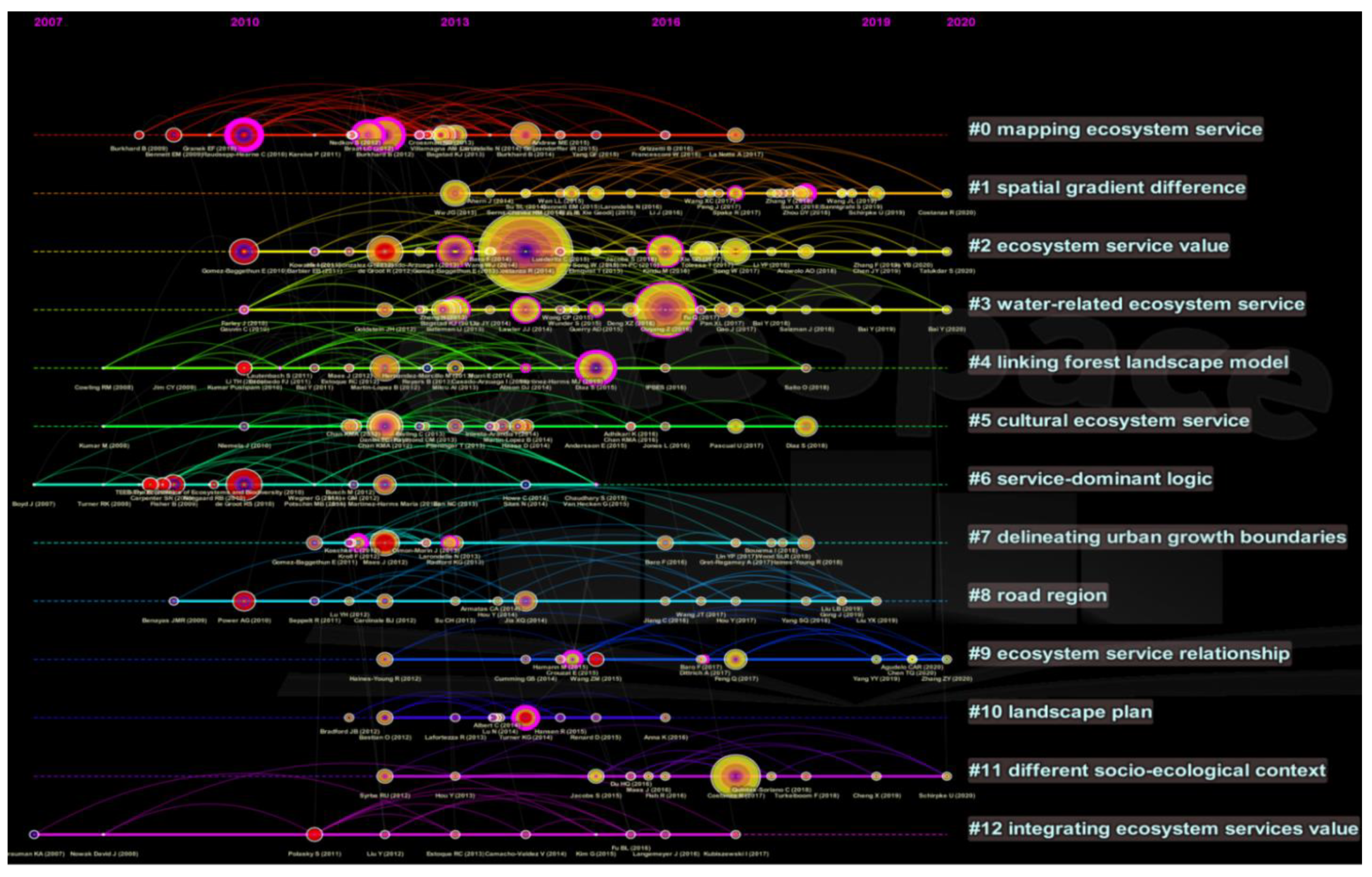
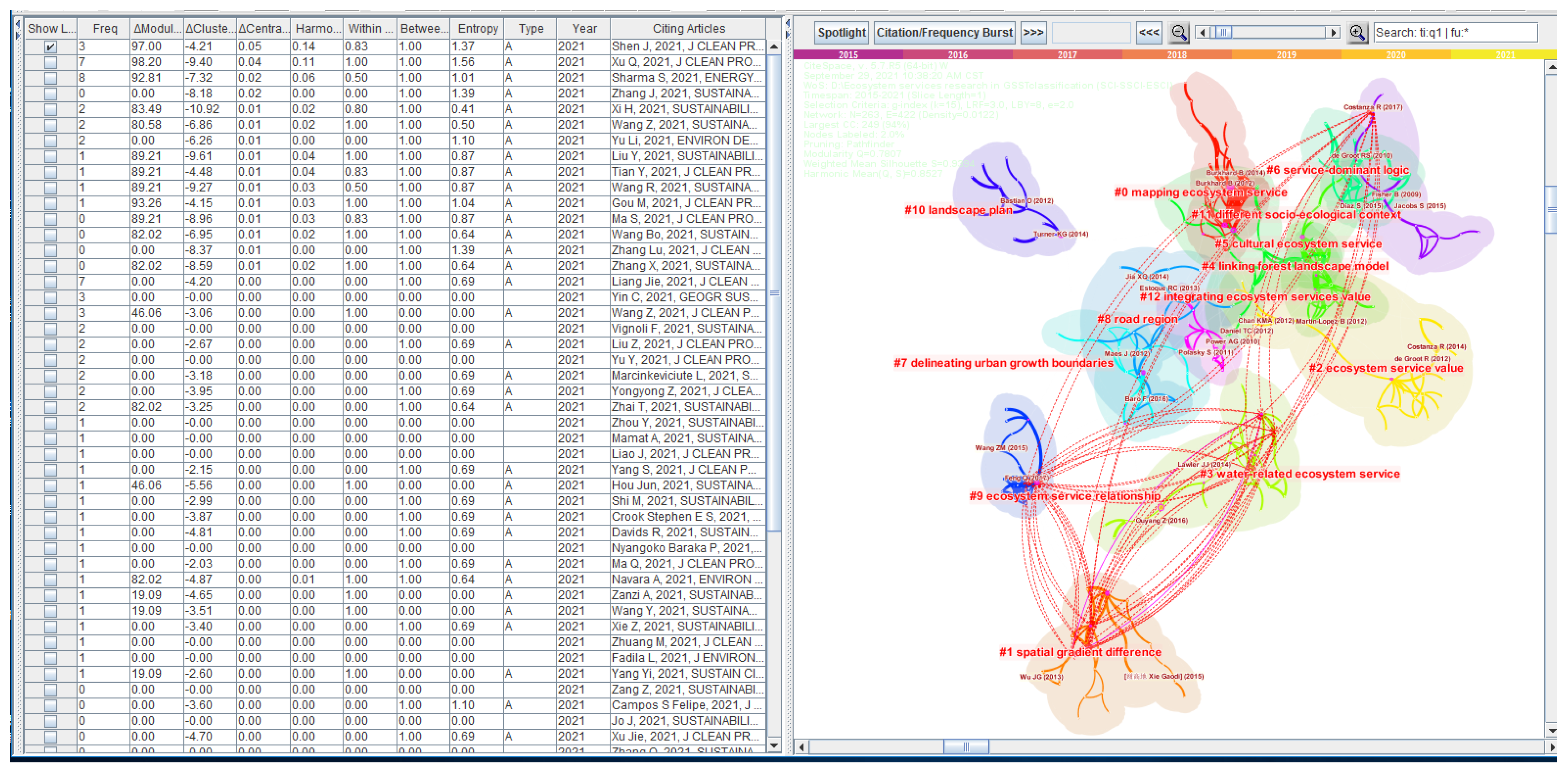
| Serial Number | The Name of the Paper | Author | Published Journals | Publication Time | Citation per Year since Publication | Number of Citations |
|---|---|---|---|---|---|---|
| 1 | Linking biodiversity, ecosystem services, and human well-being: three challenges for designing research for sustainability | Bennett E M, et al. [17] | Current Opinion in Environmental Sustainability | 2015 | 5, 28, 48, 54, 83, 69, 54 | 341 |
| 2 | Benefits of restoring ecosystem services in urban areas | Elmqvist T, et al. [18] | Current Opinion in Environmental Sustainability | 2015 | 1, 10, 23, 34, 66, 65, 55 | 254 |
| 3 | The global status and trends of Payments for Ecosystem Services | Salzman J, et al. [19] | Nature Sustainability | 2018 | 8, 37, 52, 59 | 156 |
| 4 | The role of cultural ecosystem services in landscape management and planning | Plieninger T, et al. [20] | Current Opinion in Environmental Sustainability | 2015 | 1, 16, 17, 20, 30, 22, 22 | 128 |
| 5 | Towards an ecosystem services approach that addresses social power relations | Berbes-Blazquez M, et al. [21] | Current Opinion in Environmental Sustainability | 2016 | 4, 21, 21, 34, 24, 15 | 119 |
| 6 | A social-ecological approach to managing multiple agro-ecosystem services | Lescourret F, et al. [22] | Current Opinion in Environmental Sustainability | 2015 | 3, 8, 11, 15, 20, 11, 12 | 80 |
| 7 | The impact of land-use change on water-related ecosystem services: a study of the Guishui River Basin, Beijing, China | Gao J, et al. [23] | Journal of Cleaner Production | 2017 | 1, 7, 18, 23, 29 | 78 |
| 8 | Urban ecological infrastructure: an integrated network for ecosystem services and sustainable urban systems | Li F, et al. [24] | Journal of Cleaner Production | 2017 | 3, 9, 14, 26, 14 | 66 |
| 9 | Examining multi-functionality for crop yield and ecosystem services in five systems of agroecological intensification | Garbach K, et al. [25] | International Journal of Agricultural Sustainability | 2017 | 1, 7, 14, 12, 22, 10 | 66 |
| 10 | Payments for ecosystem services in the tropics: a closer look at effectiveness and equity | Calvet-Mir L, et al. [26] | Current Opinion in Environmental Sustainability | 2015 | 2, 4, 10, 13, 16, 10, 11 | 66 |
| References | Year | Strength | Begin | End | 2015–2021 |
|---|---|---|---|---|---|
| de Groot R S, 2010, [31] ECOL COMPLEX, V7, P260, DOI 10.1016/j.ecocom.2009.10.006 | 2010 | 7.76 | 2015 | 2018 | ▃▃▃▃▂▂▂ |
| Fisher B, 2009, [32] ECOL ECON, V68, P643, DOI 10.1016/j.ecolecon.2008.09.014 | 2009 | 6.84 | 2015 | 2017 | ▃▃▃▂▂▂▂ |
| Raudsepp-Hearne C, 2010, [33] P NATL ACAD SCI USA, V107, P5242, DOI 10.1073/pnas.0907284107 | 2010 | 6.39 | 2015 | 2018 | ▃▃▃▃▂▂▂ |
| Bennett E M, 2009, [34] ECOL LETT, V12, P1394, DOI 10.1111/j.1461-0248.2009.01387.x | 2009 | 5.86 | 2015 | 2017 | ▃▃▃▂▂▂▂ |
| Carpenter S R, 2009, [35] P NATL ACAD SCI USA, V106, P1305, DOI 10.1073/pnas.0808772106 | 2009 | 4.87 | 2015 | 2017 | ▃▃▃▂▂▂▂ |
| Gómez-Baggethun E, 2010, [36] ECOL ECON, V69, P1209, DOI 10.1016/j.ecolecon.2009.11.007 | 2010 | 4.35 | 2015 | 2018 | ▃▃▃▃▂▂▂ |
| Daily G C, 2009, [37] FRONT ECOL ENVIRON, V7, P21, DOI 10.1890/080025 | 2009 | 2.91 | 2015 | 2017 | ▃▃▃▂▂▂▂ |
| Muradian R, 2010, [38] ECOL ECON, V69, P1202, DOI 10.1016/j.ecolecon.2009.11.006 | 2010 | 2.33 | 2015 | 2018 | ▃▃▃▃▂▂▂ |
| Power A G, 2010, [39] PHILOS T R SOC B, V365, P2959, DOI 10.1098/rstb.2010.0143 | 2010 | 4.65 | 2016 | 2018 | ▂▃▃▃▂▂▂ |
| Nelson E, 2009, [40] FRONT ECOL ENVIRON, V7, P4, DOI 10.1890/080023 | 2009 | 3.23 | 2016 | 2017 | ▂▃▃▂▂▂▂ |
| Kumar Pushpam, 2010, [41] EC ECOSYSTEMS BIODIV, V0, P0, DOI 10.4324/9781849775489 | 2010 | 3.23 | 2016 | 2017 | ▂▃▃▂▂▂▂ |
| Hauck J, 2013, [42] ENVIRON SCI POLICY, V25, P13, DOI 10.1016/j.envsci.2012.08.001 | 2013 | 2.69 | 2016 | 2017 | ▂▃▃▂▂▂▂ |
| Burkhard B, 2009, [43] Landscape Online, V0, P0, DOI 10.3097/LO.200915 | 2009 | 2.69 | 2016 | 2017 | ▂▃▃▂▂▂▂ |
| Norgaard R B, 2010, [44] ECOL ECON, V69, P1219, DOI 10.1016/j.ecolecon.2009.11.009 | 2010 | 2.69 | 2016 | 2017 | ▂▃▃▂▂▂▂ |
| Villamagna A M, 2013, [45] ECOL COMPLEX, V15, P114, DOI 10.1016/j.ecocom.2013.07.004 | 2013 | 2.6 | 2016 | 2017 | ▂▃▃▂▂▂▂ |
| Wang Z M, 2015, [46] SCI TOTAL ENVIRON, V514, P119, DOI 10.1016/j.scitotenv.2015.01.007 | 2015 | 3.01 | 2018 | 2019 | ▂▂▂▃▃▂▂ |
| Maes J, 2012, [47] ECOSYST SERV, V1, P31, DOI 10.1016/j.ecoser.2012.06.004 | 2012 | 2.98 | 2018 | 2019 | ▂▂▂▃▃▂▂ |
| Polasky S, 2011, [48] ENVIRON RESOUR ECON, V48, P219, DOI 10.1007/s10640-010-9407-0 | 2011 | 2.37 | 2018 | 2019 | ▂▂▂▃▃▂▂ |
| Turner K G, 2014, [49] LANDSCAPE URBAN PLAN, V125, P89, DOI 10.1016/j.landurbplan.2014.02.007 | 2014 | 2.1 | 2018 | 2019 | ▂▂▂▃▃▂▂ |
| de Groot R, 2012, [50] ECOSYST SERV, V1, P50, DOI 10.1016/j.ecoser.2012.07.005 | 2012 | 3.24 | 2019 | 2021 | ▂▂▂▂▃▃▃ |
| Haase D, 2014, [51] AMBIO, V43, P407, DOI 10.1007/s13280-014-0503-1 | 2014 | 3.01 | 2019 | 2021 | ▂▂▂▂▃▃▃ |
| Zhou D Y, 2018, [52] ECOL INDIC, V95, P152, DOI 10.1016/j.ecolind.2018.07.007 | 2018 | 2.25 | 2019 | 2021 | ▂▂▂▂▃▃▃ |
| Δ Centrality | References | Journal | Title |
|---|---|---|---|
| 0.05 | Shen et al. (2021) [59] | J CLEAN PROD | Uncovering the relationships between ecosystem services and social-ecological drivers at different spatial scales in the Beijing-Tianjin-Hebei region |
| 0.04 | Xu et al. (2021) [61] | J CLEAN PROD | Spatial gradient differences of ecosystem services supply and demand in the Pearl River Delta region |
| 0.02 | Sharma et al. (2021) [98] | ENERGY ECOL ENVIRON | Longitudinal study of changes in ecosystem services in a city of lakes, Bhopal, India |
| 0.02 | Zhang et al. (2021) [99] | SUSTAINABILITY | Linking demographic factors, land use, ecosystem services, and human well-being: Insights from an sandy landscape, Uxin in Inner Mongolia, China |
Disclaimer/Publisher’s Note: The statements, opinions and data contained in all publications are solely those of the individual author(s) and contributor(s) and not of MDPI and/or the editor(s). MDPI and/or the editor(s) disclaim responsibility for any injury to people or property resulting from any ideas, methods, instructions or products referred to in the content. |
© 2022 by the authors. Licensee MDPI, Basel, Switzerland. This article is an open access article distributed under the terms and conditions of the Creative Commons Attribution (CC BY) license (https://creativecommons.org/licenses/by/4.0/).
Share and Cite
Tang, J.; Fang, Y.; Tian, Z.; Gong, Y.; Yuan, L. Ecosystem Services Research in Green Sustainable Science and Technology Field: Trends, Issues, and Future Directions. Sustainability 2023, 15, 658. https://doi.org/10.3390/su15010658
Tang J, Fang Y, Tian Z, Gong Y, Yuan L. Ecosystem Services Research in Green Sustainable Science and Technology Field: Trends, Issues, and Future Directions. Sustainability. 2023; 15(1):658. https://doi.org/10.3390/su15010658
Chicago/Turabian StyleTang, Juan, Yudi Fang, Ziyan Tian, Yinghua Gong, and Liang Yuan. 2023. "Ecosystem Services Research in Green Sustainable Science and Technology Field: Trends, Issues, and Future Directions" Sustainability 15, no. 1: 658. https://doi.org/10.3390/su15010658
APA StyleTang, J., Fang, Y., Tian, Z., Gong, Y., & Yuan, L. (2023). Ecosystem Services Research in Green Sustainable Science and Technology Field: Trends, Issues, and Future Directions. Sustainability, 15(1), 658. https://doi.org/10.3390/su15010658





